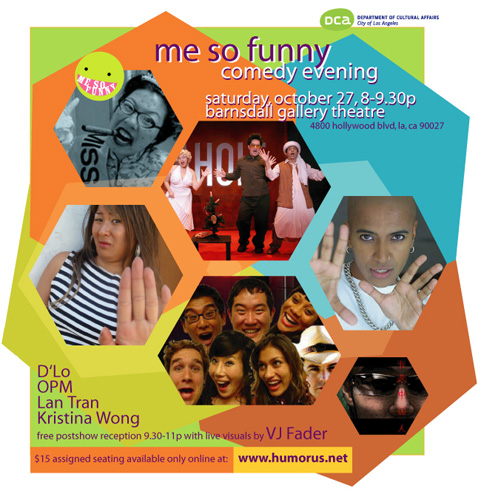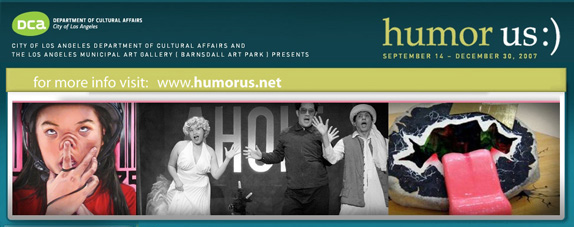 |
 |
|
|
|
City of Los Angeles Department of Cultural Affairs and the Los Angeles Municipal Art Gallery
September 14 – December 30, 2007
|
|
|||||||||
|
|||||||||
| humor us & me so funny
City of Los Angeles Department of Cultural Affairs and the Los Angeles Municipal Art Gallery September 14 – December 30, 2007 |
|||||||||
 |
September 14-December 30, 2007 | Los Angeles Municipal Art Gallery, Barnsdall Art Park, Los Angeles, CA
Why Did the Kung Pao Chicken Cross the Road?
humor us presents over one hundred works in a variety of media by twenty Asian American artists with ties to Southern California. They display strategies of play, irony, foolery, parody, and satire, with works ranging from the delightfully silly or kitschy, to those that deploy humor as forms of social engagement and critique. The exhibition as a whole seeks to create a context in which these manifestations, as well as the reception of humor, can be explored and even challenged.
Humor is evasive: the more one tries to explain it, the more it diminishes. To wit, essayist E.B. White observed, "humour can be dissected as a frog can, but the thing dies in the process and the innards are discouraging to any but the pure scientific mind." We attempt to not kill the creature: the elusive complexity of humor sharpened our desire as curators to see how artists were directly or indirectly engaging with it in their works. Moreover, we were curious to see what happens when you cross humor with Asian Americans (speaking of crossings).
In doing so, humor us questions the parameters of identity, yet also recognizes the continuing importance of race and representation. Often the butt of jokes or the comic relief within mainstream media—from Fu Manchu to William Hung of American Idol notoriety—Asians and Asian Americans are often stereotyped as eternal foreigners, model minorities, inscrutable, nerdy and yes, humorless.
Western understandings of humor have evolved from ancient Greek and Medieval origins as a system of four fluids (wet and dry humours) that governed the body and correlated to a person’s temperament. Although the physiological and medical tenets of this theory have been repudiated, humor’s connection to temperament (and by extension, humor’s subjective aspects) continue to captivate to this day. Contemporary Cultural Studies scholars David Eng and David Kazanjian posit that the concept of temperament in the ancient humours system laid a foundation for racial and ethnic categorizations; they are historically linked discourses. Other studies of humor led Freud to his theories about jokes and their relation to the unconscious, as well as to postcolonial theorist Homi Bhabha’s insight that humor is intricately linked to the construction of group identity. Among myriad variables including culture, class, age, education, gender, context, and so on that factor into the experience of humor, constructions of identity and stereotypes play an undeniable role. Southern California serves as a compelling site for humor us as it is the world’s putative media and entertainment capital and the premier gateway of Asian immigration; a site where representation and racialization, history and humor overlap. humor us highlights artists who are themselves the creative stewards of comedy. These artists have taken the bull(frog) by its horns, ridden it, milked it, or set it loose in the China shop.
Participating Artists
humor us highlights artists who have taken humor into their own hands, and also examines the role of cultural specificity in the operations and reception of humor. They include Shane Abad, Tetsuji Aono, Susan Choi, Young Chung, Allan deSouza, Cirilo Domine, Reanne Estrada, Pearl Hsiung, Terence Koh, Byoung Ok Koh, kozyndan, Đỉnh Q. Lê, Candice Lin, Sandra Low, Sandeep Mukherjee, UuDam Nguyễn, Kaz Oshiro, Joey Santarromana, Anna Sew Hoy, and Niphan Suwannakas
humor us is curated by guest curators Việt Lê, Yong Soon Min, and Leta Ming.
 |